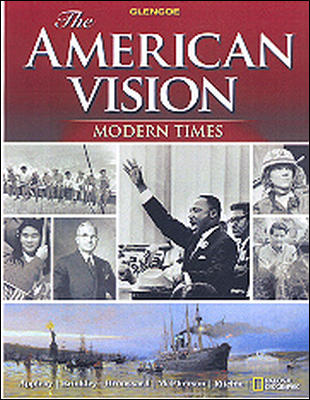The American Vision Modern Times © 2010Chapter 2:
The Young Republic, 1789-1850Student Web Activity Lesson PlansIntroduction
Students have read about the United States’s belief in Manifest Destiny and recognize that the acquisition of California, Oregon, and Texas was important in making this idea a reality. Students learned about the tensions that arose between Texas settlers and the Mexican government and the struggle for Texas independence that ensued. In this activity students will take a closer look at one strategic battle in the Texans’ fight for independence — the battle of the Alamo.
Lesson Description
Students will use information from the Battle of the Alamo Web site to learn
about important figures and events concerning the battle. They will read a summary
of the battle, quotes by eyewitnesses, and letters written by William Travis
and General Santa Anna. Students will then answer four questions and apply this
information by leading a classroom discussion about the reasons why the American
public popularized the battle of the Alamo.
Instructional Objectives- Students will identify major figures in the battle of the Alamo and describe
the battle's defining characteristics.
- Students will be able to use this knowledge to lead a classroom discussion
about why the battle of the Alamo captured the imaginations of the public.
Student Web Activity Answers- Before Santa Anna arrived at the Alamo, there were about 120 volunteers
defending the garrison. James Bowie, renowned inventor of the Bowie knife,
commanded a group of those volunteers. Davy Crockett, the famous frontiersman
and state senator, was also among the volunteers at the Alamo. William Travis
arrived with 30 men from the regular army. Even though the group knew they
were greatly outnumbered by the Mexican army, they were resolute in their
determination to maintain control of the Alamo at any cost.
- Sam Houston ordered James Bowie to destroy the Alamo. He felt that the post
was too vulnerable. James Neill and James Bowie, however, thought that it
was a good strategic position for the Texans, and they decided to keep and
defend the garrison.
- Travis believed that defending the Alamo was a matter of personal honor
and that it was his responsibility as an American citizen to do so.
- In his letter, written nearly 38 years after the battle, Santa Anna cites
Travis's refusal to surrender and Sam Houston's impending arrival at
the Alamo for his decision to take the fort with force.
- Students' discussions and summaries will vary but should include information
about the emotional appeal of the small band defending the fort against an
army, the motivational value of the letter, the appearance of the letter in
media, and the fame of the individuals within the Alamo.
 | 




